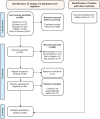Focus on the blind spots of clinician-patient interactions: A critical narrative review of collusion in medical setting
- PMID: 39344251
- PMCID: PMC12227811
- DOI: 10.1177/13591053241284197
Focus on the blind spots of clinician-patient interactions: A critical narrative review of collusion in medical setting
Abstract
Collusions, interpersonal phenomena with an impact on patients, significant others, clinicians, and care, are mainly described in the psychotherapeutic literature but also occur in the medical setting. Comprehended as an unconscious bond between two or more persons from a psychotherapeutic perspective, definitions and collusive situations described in the medical setting vary. The question arises whether medical collusions, compared to collusions occurring in the psychiatric setting emerge in different clinical situations or are not identified as transference-countertransference experiences, since there is less sensitivity for the unconscious dimensions of care. We systematically reviewed the medical literature on collusions. Even though a read threat, avoidance of unpleasant feelings (mainly anxiety), runs through the described collusions, the unconscious dimensions and associated defensive maneuvers are rarely evoked. Given the expressed desire to act on collusions in medicine, involving third-party psychiatric liaison clinicians, who supervise clinicians, and hereby help to disentangle collusions, could be beneficial.
Keywords: clinician-patient interaction; collusion; communication; doctor patient relationship; non-disclosure of medical information.
Conflict of interest statement
Declaration of conflicting interestsThe authors declared no potential conflicts of interest with respect to the research, authorship, and/or publication of this article.
Figures
Similar articles
-
Interventions for interpersonal communication about end of life care between health practitioners and affected people.Cochrane Database Syst Rev. 2022 Jul 8;7(7):CD013116. doi: 10.1002/14651858.CD013116.pub2. Cochrane Database Syst Rev. 2022. PMID: 35802350 Free PMC article.
-
Patient-doctor communication.Med Clin North Am. 2003 Sep;87(5):1115-45. doi: 10.1016/s0025-7125(03)00066-x. Med Clin North Am. 2003. PMID: 14621334
-
Sexual Harassment and Prevention Training.2024 Mar 29. In: StatPearls [Internet]. Treasure Island (FL): StatPearls Publishing; 2025 Jan–. 2024 Mar 29. In: StatPearls [Internet]. Treasure Island (FL): StatPearls Publishing; 2025 Jan–. PMID: 36508513 Free Books & Documents.
-
The Black Book of Psychotropic Dosing and Monitoring.Psychopharmacol Bull. 2024 Jul 8;54(3):8-59. Psychopharmacol Bull. 2024. PMID: 38993656 Free PMC article. Review.
-
Factors that impact on the use of mechanical ventilation weaning protocols in critically ill adults and children: a qualitative evidence-synthesis.Cochrane Database Syst Rev. 2016 Oct 4;10(10):CD011812. doi: 10.1002/14651858.CD011812.pub2. Cochrane Database Syst Rev. 2016. PMID: 27699783 Free PMC article.
References
-
- Armstrong D. (1987) Silence and truth in death and dying. Social Science & Medicine 24(8): 651–657. - PubMed
-
- Atkinson S, McNamara PM. (2017) Unconscious collusion: An interpretative phenomenological analysis of the maternity care experiences of women with obesity (BMI≥30kg/m2). Midwifery 49: 54–64. - PubMed
-
- Ayres I. (1987) How cartels punish: A structural theory of self-enforcing collusion. Columbia Law Review 87(2): 295–325.
-
- Back AL, Arnold RM, Baile WF, et al. (2005) Approaching difficult communication tasks in oncology. CA A Cancer Journal for Clinicians 55(3): 164–177. - PubMed
-
- Balint M. (2005) The Doctor, His Patient and the Illness. London: Churchill Livingstone.
Publication types
MeSH terms
LinkOut - more resources
Full Text Sources
Medical


